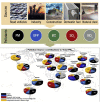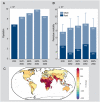Heart healthy cities: genetics loads the gun but the environment pulls the trigger
- PMID: 34005032
- PMCID: PMC8248996
- DOI: 10.1093/eurheartj/ehab235
Heart healthy cities: genetics loads the gun but the environment pulls the trigger
Abstract
The world's population is estimated to reach 10 billion by 2050 and 75% of this population will live in cities. Two-third of the European population already live in urban areas and this proportion continues to grow. Between 60% and 80% of the global energy use is consumed by urban areas, with 70% of the greenhouse gas emissions produced within urban areas. The World Health Organization states that city planning is now recognized as a critical part of a comprehensive solution to tackle adverse health outcomes. In the present review, we address non-communicable diseases with a focus on cardiovascular disease and the urbanization process in relation to environmental risk exposures including noise, air pollution, temperature, and outdoor light. The present review reports why heat islands develop in urban areas, and how greening of cities can improve public health, and address climate concerns, sustainability, and liveability. In addition, we discuss urban planning, transport interventions, and novel technologies to assess external environmental exposures, e.g. using digital technologies, to promote heart healthy cities in the future. Lastly, we highlight new paradigms of integrative thinking such as the exposome and planetary health, challenging the one-exposure-one-health-outcome association and expand our understanding of the totality of human environmental exposures.
Keywords: Air pollution; Environmental stressors; Heart healthy city; Heat islands effects; Light pollution; Noise pollution; Urban and transport planning and design interventions.
© The Author(s) 2021. Published by Oxford University Press on behalf of the European Society of Cardiology.
Figures







References
-
- World Health Organization. Global Action Plan for the Prevention and Control of Noncommunicable Diseases 2013–2020. Geneva: WHO; 2013. https://apps.who.int/iris/bitstream/handle/10665/94384/9789241506236_eng...?. Date accessed 31 March 2021.
-
- Lozano R, Naghavi M, Foreman K, Lim S, Shibuya K, Aboyans V, Abraham J, Adair T, Aggarwal R, Ahn SY, Alvarado M, Anderson HR, Anderson LM, Andrews KG, Atkinson C, Baddour LM, Barker-Collo S, Bartels DH, Bell ML, Benjamin EJ, Bennett D, Bhalla K, Bikbov B, Bin Abdulhak A, Birbeck G, Blyth F, Bolliger I, Boufous S, Bucello C, Burch M, Burney P, Carapetis J, Chen H, Chou D, Chugh SS, Coffeng LE, Colan SD, Colquhoun S, Colson KE, Condon J, Connor MD, Cooper LT, Corriere M, Cortinovis M, de Vaccaro KC, Couser W, Cowie BC, Criqui MH, Cross M, Dabhadkar KC, Dahodwala N, De Leo D, Degenhardt L, Delossantos A, Denenberg J, Des Jarlais DC, Dharmaratne SD, Dorsey ER, Driscoll T, Duber H, Ebel B, Erwin PJ, Espindola P, Ezzati M, Feigin V, Flaxman AD, Forouzanfar MH, Fowkes FG, Franklin R, Fransen M, Freeman MK, Gabriel SE, Gakidou E, Gaspari F, Gillum RF, Gonzalez-Medina D, Halasa YA, Haring D, Harrison JE, Havmoeller R, Hay RJ, Hoen B, Hotez PJ, Hoy D, Jacobsen KH, James SL, Jasrasaria R, Jayaraman S, Johns N, Karthikeyan G, Kassebaum N, Keren A, Khoo JP, Knowlton LM, Kobusingye O, Koranteng A, Krishnamurthi R, Lipnick M, Lipshultz SE, Ohno SL, Mabweijano J, MacIntyre MF, Mallinger L, March L, Marks GB, Marks R, Matsumori A, Matzopoulos R, Mayosi BM, McAnulty JH, McDermott MM, McGrath J, Mensah GA, Merriman TR, Michaud C, Miller M, Miller TR, Mock C, Mocumbi AO, Mokdad AA, Moran A, Mulholland K, Nair MN, Naldi L, Narayan KM, Nasseri K, Norman P, O'Donnell M, Omer SB, Ortblad K, Osborne R, Ozgediz D, Pahari B, Pandian JD, Rivero AP, Padilla RP, Perez-Ruiz F, Perico N, Phillips D, Pierce K, Pope CA, 3rd Porrini E, Pourmalek F, Raju M, Ranganathan D, Rehm JT, Rein DB, Remuzzi G, Rivara FP, Roberts T, De Leon FR, Rosenfeld LC, Rushton L, Sacco RL, Salomon JA, Sampson U, Sanman E, Schwebel DC, Segui-Gomez M, Shepard DS, Singh D, Singleton J, Sliwa K, Smith E, Steer A, Taylor JA, Thomas B, Tleyjeh IM, Towbin JA, Truelsen T, Undurraga EA, Venketasubramanian N, Vijayakumar L, Vos T, Wagner GR, Wang M, Wang W, Watt K, Weinstock MA, Weintraub R, Wilkinson JD, Woolf AD, Wulf S, Yeh PH, Yip P, Zabetian A, Zheng ZJ, Lopez AD, Murray CJ, AlMazroa MA, Memish ZA. Global and regional mortality from 235 causes of death for 20 age groups in 1990 and 2010: a systematic analysis for the Global Burden of Disease Study 2010. Lancet 2012;380:2095–2128. - PMC - PubMed
-
- World Health Organization. Projections of mortality and causes of death, 2016 to 2060. https://www.who.int/healthinfo/global_burden_disease/projections/en/. Date accessed 31 March 2021.
-
- World Health Organization. Noncommunicable diseases: mortality. https://www.who.int/gho/ncd/mortality_morbidity/en/. Date accessed 31 March 202.
Publication types
MeSH terms
Grants and funding
LinkOut - more resources
Full Text Sources
Other Literature Sources
Medical

